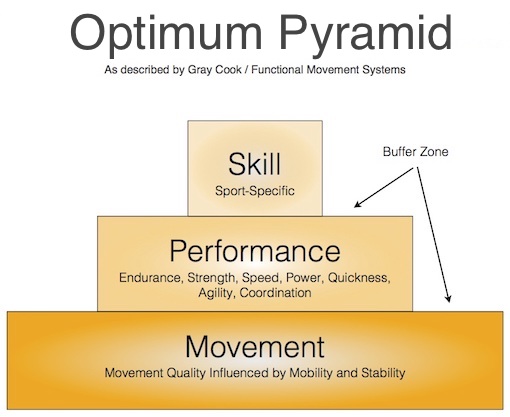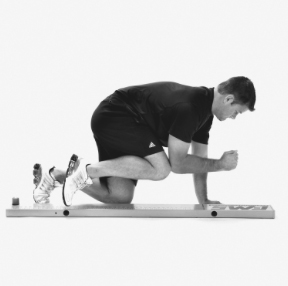
The Important Difference Between Strengthening and Stabilization Exercises
What the heck is a stabilization exercise? Does it make your core stronger?
But if it strengthens your core, is it a strengthening exercise or a stabilization exercise?
To add to confusion, an exercise labeled as “strengthening” may be doing a great job challenging your stabilization elsewhere in the body. So is that exercise strengthening, stabilizing, or both?
Why does it have to be so confusing!?! What’s the real difference between a stabilization exercise and a strengthening exercise?
Here’s the most simple way I have to explain it…
Stabilization exercises address an issue of quality, and strengthening exercises address an issue of quantity.
The Performance Pyramid
Physical therapist and author Gray Cook has described the Performance Pyramid which helps us visualize the difference between movement and performance.
The figure to the right is the adapted form of his Optimum Performance Pyramid which shows that the body’s systems are in balance. Check out Part III of my Manifesto explaining why this is important.
You can clearly see the three pillars stacked on top of each other. This is your ideal set-up. Skill is supported by an adequate level of Performance, which is supported by an adequate level of Movement.
The pillar labeled Skill may refer to the sport-specific or activity-specific skills required in your sport or fitness pursuits, or to the job-specific tasks you encounter at work and at home.
The pillar labeled Performance includes measures of physical capacity, which may include power, strength, speed, endurance, etc.
The pillar labeled Movement is really a measure of quality (that’s important to remember!)— it represents your ability to both produce and control movement through a full range of functional patterns.
No doubt you’ve noticed this isn’t really a true pyramid — there’s a step-off pattern to the stacking of pillars. This allows for a buffer zone between Movement, Performance, and Skill. A properly constructed buffer zone implies the pillar below exceeds the needs of the pillar above.
For example, the buffer zone between Performance and Movement shows that the functional movements are more than adequate to handle the power generated. Without the buffer, there may be potential for injury or compromised performance.
Defining Stabilization and Strength
Let’s get back to our question — what’s the difference between a stabilization exercise and a strength exercise?
I said before that strengthening exercises address an issue of quantity. When working to improve strength you are performing an activity that can be measured. That falls squarely into the Performance pillar.
For example…
How long can you hold the position? How much weight can you move? How fast can you move the weight?
These are all questions that point to quantity, and therefore performance.
When you perform a stabilization exercise you aren’t concerned with those questions.
You’re instead concerned about feel. That means you’re heavily dependent upon sensory information — pressure, vibration, skin stretch, tension on muscles and tendons, position of joints, etc. — to help your body make the necessary adjustments to keep you in your desired position.
Remember, stabilization exercises address an issue of quality — part of the Movement pillar.
How does it feel to shift your weight this way or that? Can you hold position as an extremity moves or does something change? Do you recognize muscles activating?
Certain aspects of stabilization exercises may seem very black and white…
You either do or you don’t. Success or failure. Ideal or compensated.
But there is a whole lot of gray in between because of your body’s ability to adapt (aka, compensate).
What Needs Do You Have?
A simple screen like the Functional Movement Screen (FMS) can tell you if your movement — including your fundamental stability — meet the requirements of your life’s chosen activities.
If you meet these movement requirements, then you’re focus can be on strength and power (so long as you maintain a healthy level of movement).
In my experience, most people are convinced they need strengthening. But in all likelihood you really need to expand upon your foundation of movement. Your results on the FMS will make your needs obvious.
What you feel and describe as “weakness” may be nothing more than a problem of adaptability. Physical therapist and strength coach Charlie Weingroff defines stability as “control in the presence of change”. He is describing an adaptable system.
Stabilization exercise should make you more adaptable because it will address your movement competency.
In other words, if your joints and muscles are capable of allowing a full motion passively, then your body’s movement system should be able to produce that full motion and control it.
I don’t want to burst any egos by saying this, but in my experience there are many more people who need stabilization work before they focus on getting stronger. They need to know how to control positions. If you can control a position, then you can breathe easily and effortlessly move into and out of that position.
I look at this very simply — if you can’t control a basic position without compensating…
And you’re performing strength exercises in that same position…
Then all you’re really doing is strengthening a compensation! You’re building a house of cards. And it could come crashing down at any moment!
My recommendation for anyone who’s active in sports or fitness is to have a simple movement screen like the FMS performed. It’ll open your eyes to how you move.
Let’s face it, the way in which you move feels “normal” to you. But that doesn’t mean that it’s adequate.
Focusing on the Performance pillar — with exercise to increase power, endurance, strength, etc. — is going to keep you from performing at your highest potential unless you are sure you have met the standard for the Movement pillar.
Do yourself a favor and take a little time to assess and correct your movement now. Movement supports Performance. Don’t limit yourself (or worse, injure yourself!) by ignoring your quality of movement.
Are you interested in learning if your body needs more help with Movement or is ready to push the Performance?
Or do you have other questions about problems you’ve been having with your body?
I’m happy to schedule you for a 60-minute BreakThrough Consultation so you can get your questions answered.
In your BreakThrough Consultation, you’ll tell me about your issues and concerns, I’ll ask you additional detailed questions, and then I’ll put you through an assessment. Once I have the necessary information, I’ll be able to let you know…
What I see going on in your body…
How I would suggest correcting the problem…
How long I would expect it to take for you to meet your goals…
And answer your specific questions as best as possible.
It’s an easy first step…There’s no need to call your doctor for a prescription…No need to check with your insurance first…And no obligation to schedule further treatment with me…
The BreakThrough Consultation may be a complete game-changer towards the progress you want. Make an informed decision about what’s best for you! Click the orange button above to get started on the right path!!!


